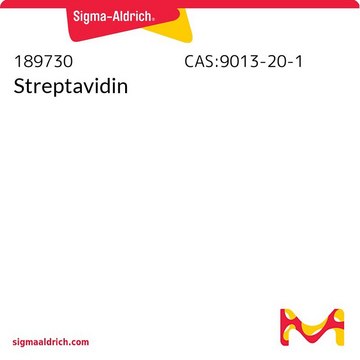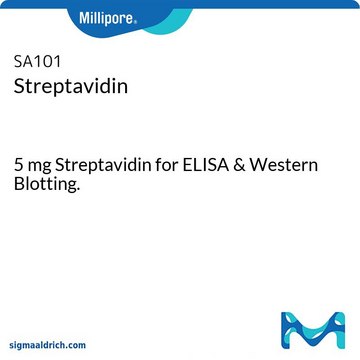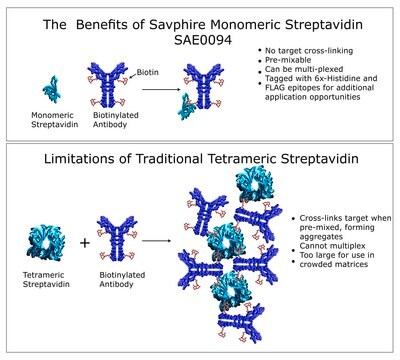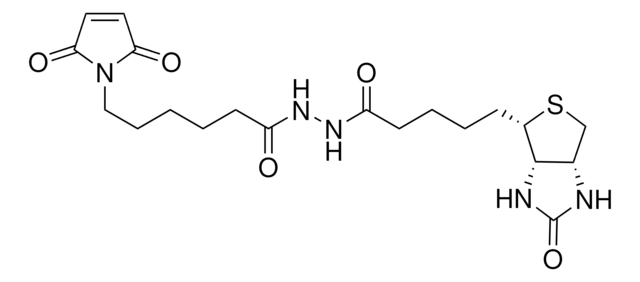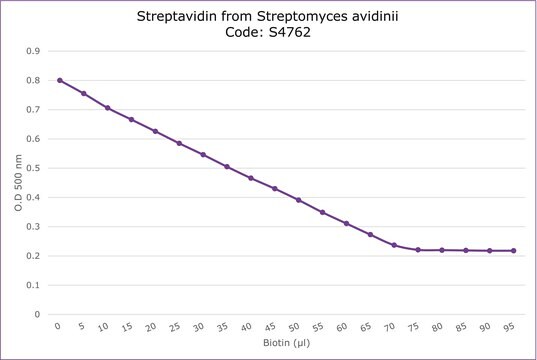S9415
Streptavidin−Maleimide from Streptomyces avidinii
Sinônimo(s):
Streptavidin Conjugate
Faça loginpara ver os preços organizacionais e de contrato
About This Item
Produtos recomendados
Extensão da rotulagem
4-10 mol maleimide per mol Streptavidin
Nível de qualidade
adequação
suitable for direct conjugation to compounds containing free sulfhydryl groups
temperatura de armazenamento
−20°C
Categorias relacionadas
Descrição geral
Streptavidin conjugated compounds may be used in avidin/strepavidin:biotin-based detection systems.
Streptavidin is a protein produced by the bacterium Streptomyces avidinii. It has four binding sites for biotin, as does avidin. Both have been used extensively as probes in immunochemical systems, conjugated to antibodies, enzymes or fluorochromes. However, avidin is highly basic (pI ~ 10.5), compared to streptavidin (pI ~ 5-6). Avidin has a slightly higher binding capacity for biotin than streptavidin does, but it has glycosylated side chains which give higher backgrounds in blotting techniques than does streptavidin, which is not a glycoprotein. Streptavidin is more resistant than avidin to dissociation into subunits by guanidinium chloride.
Aplicação
Maleimide Activated Streptavidin is used to prepare streptavidin-protein conjugates with proteins, peptides and other molecules that contain a free sulfhydryl (-SH) group. Activated streptavidin presents an available maleimide group that reacts with sulfhydryl-containing molecules.
forma física
Lyophilized powder containing sodium citrate.
Nota de preparo
Streptavidin, from Streptomyces avidinii, activated with maleimidocaproic acid N-hydroxysuccinimide ester.
Exoneração de responsabilidade
Unless otherwise stated in our catalog or other company documentation accompanying the product(s), our products are intended for research use only and are not to be used for any other purpose, which includes but is not limited to, unauthorized commercial uses, in vitro diagnostic uses, ex vivo or in vivo therapeutic uses or any type of consumption or application to humans or animals.
Código de classe de armazenamento
11 - Combustible Solids
Classe de risco de água (WGK)
WGK 3
Ponto de fulgor (°F)
Not applicable
Ponto de fulgor (°C)
Not applicable
Equipamento de proteção individual
Eyeshields, Gloves, type N95 (US)
Escolha uma das versões mais recentes:
Já possui este produto?
Encontre a documentação dos produtos que você adquiriu recentemente na biblioteca de documentos.
Os clientes também visualizaram
B Mygind et al.
European journal of biochemistry, 59(2), 365-372 (1975-11-15)
1. The transport of pyrimidine mucleosides into cells of Escherichis coli has been investigated in mutant strains which cannot metabolize these nucleosides. Such cells transport and concentrate purimidine mucleosides several hindredfold. 2. The transport is inhibited by energy poisons and
Abraham Wolcott et al.
The journal of physical chemistry. B, 110(11), 5779-5789 (2006-03-17)
Quantum dots (QDs) have been increasingly used in biolabeling recently as their advantages over molecular fluorophores have become clear. For bioapplications QDs must be water-soluble and buffer stable, making their synthesis challenging and time-consuming. A simple aqueous synthesis of silica-capped
New procedures for preparation and isolation of conjugates of proteins and a synthetic copolymer of D-amino acids and immunochemical characterization of such conjugates.
F T Liu et al.
Biochemistry, 18(4), 690-693 (1979-02-20)
Kitagawa, T., et al.
Chemical & Pharmaceutical Bulletin, 29(4), 1131-1131 (1981)
R J Duncan et al.
Analytical biochemistry, 132(1), 68-73 (1983-07-01)
A synthesis of the N-hydroxysuccinimide ester of S-acetylthioacetic acid is described. This material is stable when stored dry and has advantages over the currently available reagents used to introduce sulfhydryl groups into a variety of proteins. Proteins modified with this
Nossa equipe de cientistas tem experiência em todas as áreas de pesquisa, incluindo Life Sciences, ciência de materiais, síntese química, cromatografia, química analítica e muitas outras.
Entre em contato com a assistência técnica